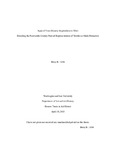Signs of Yuan Dynasty Imperialism in Tibet: Decoding the Fourteenth-Century Painted Representations of Textiles at Shalu Monastery (thesis)

View/
Author
Cribb, Betsy B.
Subject
Washington and Lee University -- Honors in Art History
Textile fabrics
China -- Tibet Autonomous Region
Fourteenth century
Shalu (Monastery)
Mongols--Social life and customs
Yuan Dynasty (China)
Metadata
Show full item recordDescription
Thesis; [FULL-TEXT FREELY AVAILABLE ONLINE] Betsy B. Cribb is a member of the Class of 2015 of Washington and Lee University. Two primary questions guide my thesis. First, why did the Mongols, one of the most powerful empires of Asia ruling Tibet at the time (1279-1368), not establish their own aesthetic or simply import one of the well established Chinese aesthetic systems associated with courtly patronage to Shalu? And second, why do the painted representations of textiles in Shalu's Kanjur Lhakang, specifically, as opposed to another stylistic element, signal the Yuan-dynasty Mongols' politically motivated appropriation of the Himalayan aesthetic?